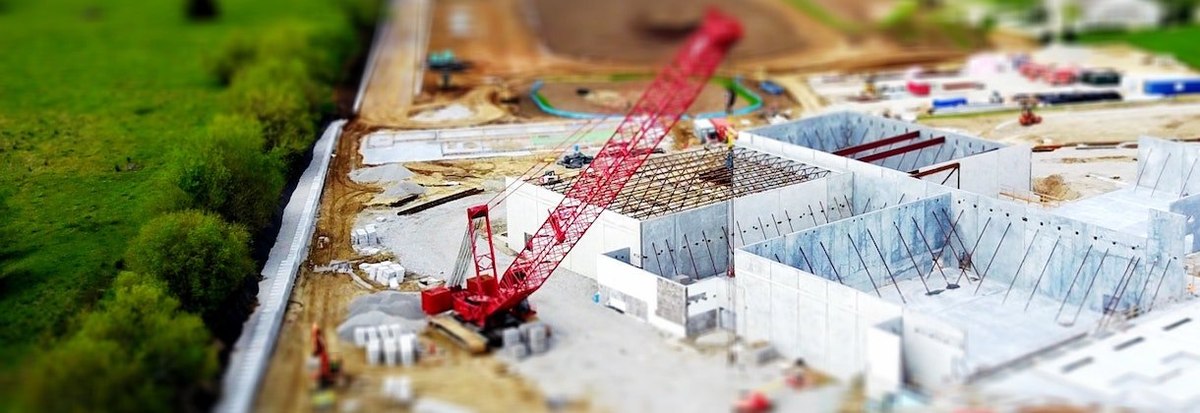The past few years have proven tumultuous for real-estate developers, as well as Americans looking to buy, sell, and rent property: Demand for housing has increased, supply has dwindled, and prices continue to rise. While many Americans support development in the abstract, recognizing that new housing construction has not kept pace with population growth, not everyone is on board when it comes to making room for new development in their local area. Recently, conflicts have escalated between people who oppose local development (sometimes referred to pejoratively as NIMBYs, as in, "not in my backyard") and people who support it (sometimes referred to as YIMBYs, for "yes in my backyard").
To better understand which groups of Americans support a variety of types of development and in which circumstances, we asked 1,000 U.S. adult citizens their opinions on what they’d like to see built, both within their area and in the country at large. In the survey, a randomly selected half of respondents were asked whether they support 30 types of development in their local community ("a new ___ in your local area"), while the other half were asked whether they support the same forms of development in the U.S. ("more ___ in this country"). Randomly assigning people to each group allowed us to compare support for each kind of development locally and nationally — among Americans overall, as well as by party and homeowner status — without asking the same person both sets of questions, where whichever question was asked first might have affected responses to the second.
Support for national vs. local development
We find that on average, Americans are more likely to support national development than they are to support local development — with exceptions for particular scenarios. The kinds of development we polled about that Americans are most likely to support nationally relative to locally include the building of waste-management facilities, prisons, drug rehabilitation centers, and homeless shelters. On the flip side, more people support local rather than national development of fast-food chains, offices, and retail stores.
The following chart demonstrates the gap between how much Americans want dozens of types of development to be built near them and how much they want each type to be built nationwide:
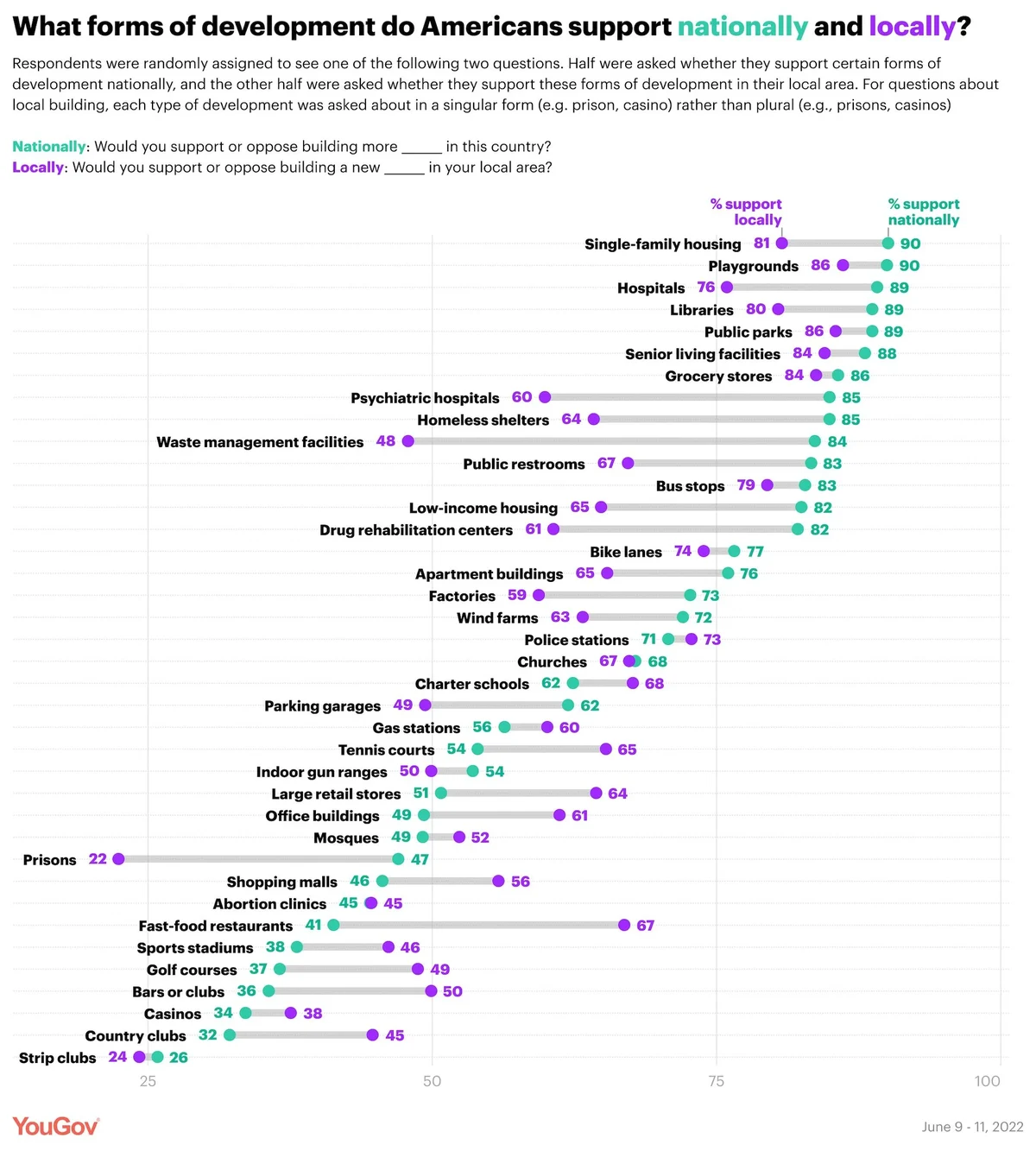
The types of development that we find are more likely to be supported at the national level than in people’s communities include buildings designed to house some of the people on the margins of society: psychiatric patients, prisoners, drug addicts, people who are homeless, and people who have low incomes. However, the largest gap in support is for waste-management facilities.
The largest gaps in support for national development over local:
- Waste-management facilities (84% support nationally; 48% support locally)
- Psychiatric hospitals (85% nationally; 60% locally)
- Prisons (47% nationally; 22% locally)
- Drug rehabilitation centers (82% nationally; 61% locally)
- Homeless shelters (85% nationally; 64% locally)
- Low-income housing (82% nationally; 65% locally)
- Hospitals (88% nationally; 70% locally)
- Public restrooms (83% nationally; 67% locally)
A few forms of development polled about are more likely to be supported locally rather than nationally. These include forms of commercial development that the average resident may personally benefit from, including fast-food restaurants, bars, and retail stores.
The largest gaps in support for local over national development:
- Fast-food restaurants (67% support locally; 41% support nationally)
- Bars or clubs (50% locally; 36% nationally)
- Large retail stores (64% locally; 51% nationally)
- Country clubs (45% locally; 32% nationally)
- Golf courses (49% locally; 37% nationally)
You can sort and search the data for national and local support of development using the table below:
Support for development among Republicans and Democrats
Some commentators have argued that, unlike on most issues, stances on development transcend partisan lines. In other words, both Republicans and Democrats can — under certain circumstances — oppose development locally while supporting it nationally. While our poll finds some truth in this argument, we also find that in aggregate, the views of Republicans and Democrats do differ in significant ways. Though members of each major party are about equally likely to support development nationally — average support among all types of development polled is 63% among Republicans and 66% among Democrats — support is 10 percentage points lower, on average, among Republicans for the same types of development in their local area versus nationally. The same is not true for Democrats, whose average support remains the same regardless of whether they’re asked about building in their community or around the country.
Republicans and Democrats also have different preferences on what they’d like to see built, both nationally and locally.
Republicans are more likely than Democrats to support building each of the following, on both a national and local level:
- Indoor gun ranges
- Police stations
- Charter schools
- Fast-food restaurants
- Churches
Democrats are more likely than Republicans to support building:
- Abortion clinics
- Wind farms
- Mosques
- Bike lanes
- Strip clubs
- Apartment buildings
- Low-income housing
- Homeless shelters
This is not to say Republicans and Democrats disagree on everything. They're equally likely to back certain forms of development, such as playgrounds, public parks, senior living facilities, tennis courts, grocery stores, and hospitals.
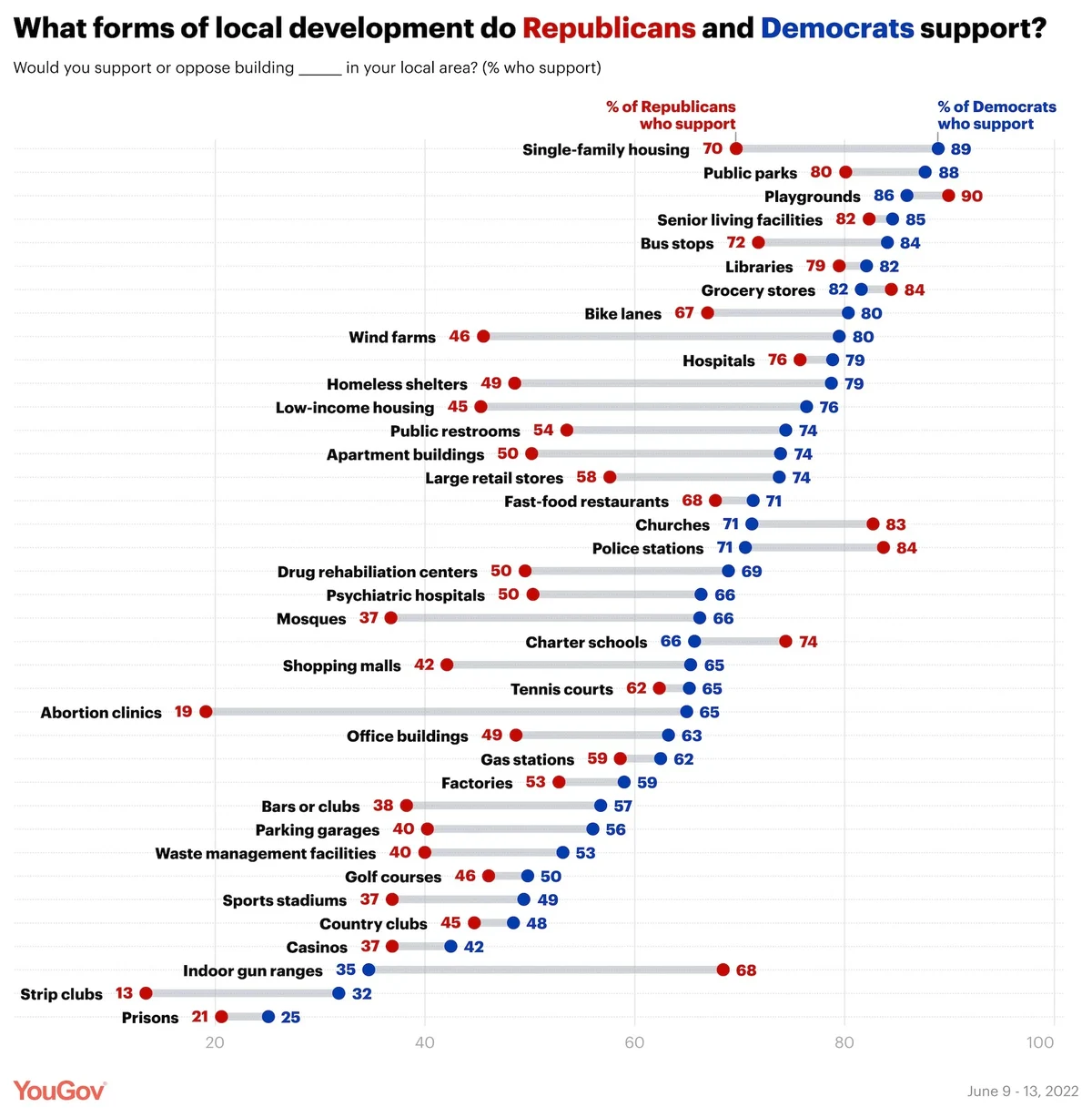
Among the most striking examples of the Republican gap in support for national over local development is prisons: While 73% of Republicans support building more prisons in the U.S., only 21% support building a new prison in their local community. Among Democrats, the gap is much smaller: 28% support building more prisons nationally and 25% support building one locally. So while Republicans are more than twice as likely as Democrats to support prison construction nationally, they’re slightly less likely than Democrats to support prison construction locally.
The construction of homeless shelters also receives a high level of support from Republicans at the national level (79%) but far less support at the local level (49%). Among Democrats, the gap is smaller: 90% support building homeless shelters nationally and 79% support doing so locally. The same goes for psychiatric hospitals: While 89% of Republicans support building psychiatric hospitals nationally, only 50% support doing so locally. Among Democrats, support levels in the two contexts are closer to each other: 81% nationally and 66% locally.
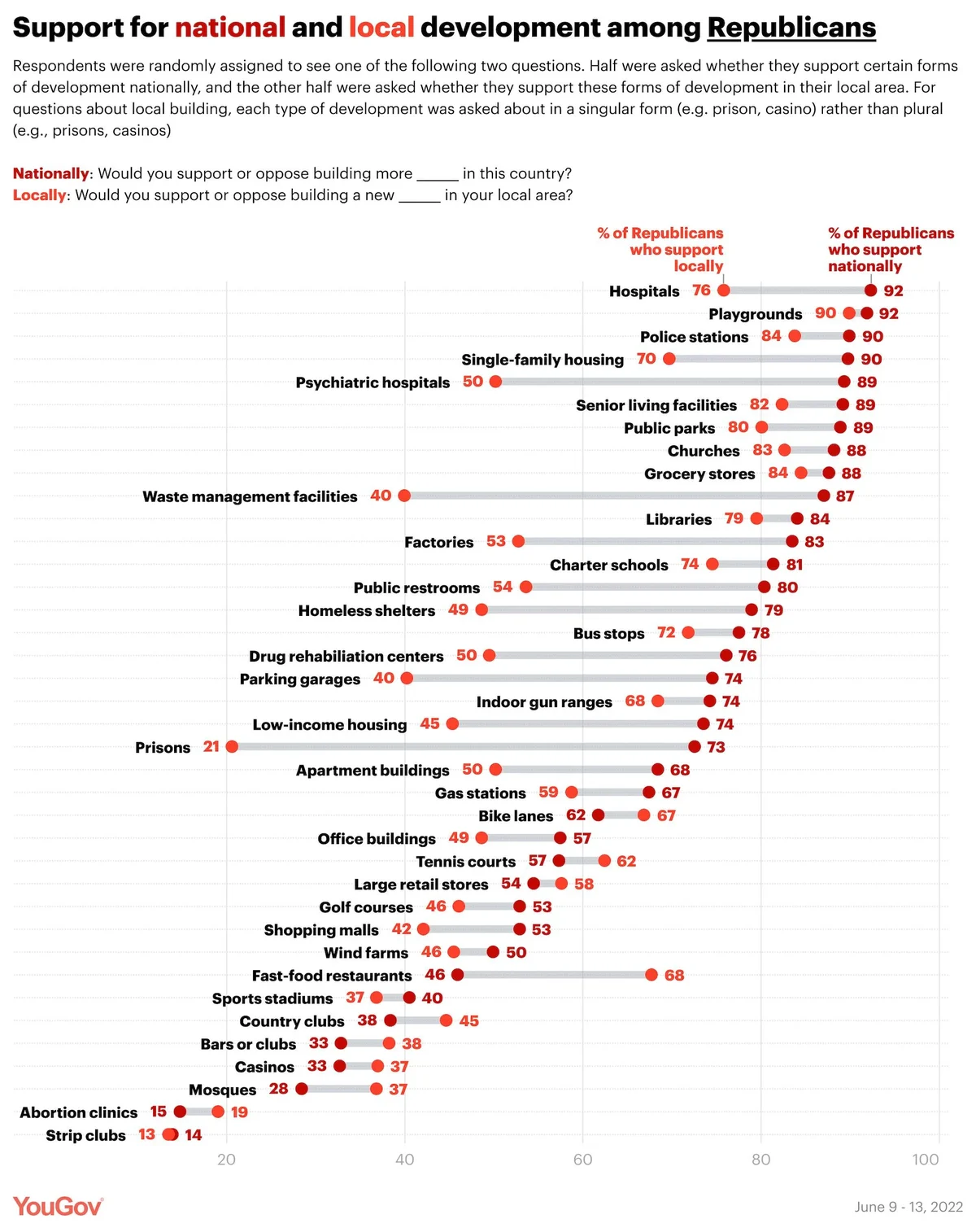
Like Republicans, Democrats do prefer that certain types of development occur nationally rather than locally, though for fewer of the kinds of development polled than for Republicans — and to a lesser extent, on average. Members of both parties, for example, are more likely to express support for national rather than local development of waste management facilities, rehab centers, and hospitals. While there are only a few instances in which Republicans exhibit the opposite tendency – preferring local to national development – this phenomenon is far more common among Democrats. For example, 71% of Democrats support a new fast-food restaurant in their area, but only 37% support building more fast-food restaurants nationally. Among Republicans, the gap is much smaller: 68% support locally vs. 50% nationally. The same pattern holds for large retail stores: 74% of Democrats support building one in their area, while only 49% support constructing more nationwide. Among Republicans, these figures are 58% and 54%, respectively. Partisan desire for certain kinds of local development might reflect in part the greater likelihood that Democrats live in cities, relative to Republicans: In our survey, Democrats were more than twice as likely as Republicans to reside in a city.
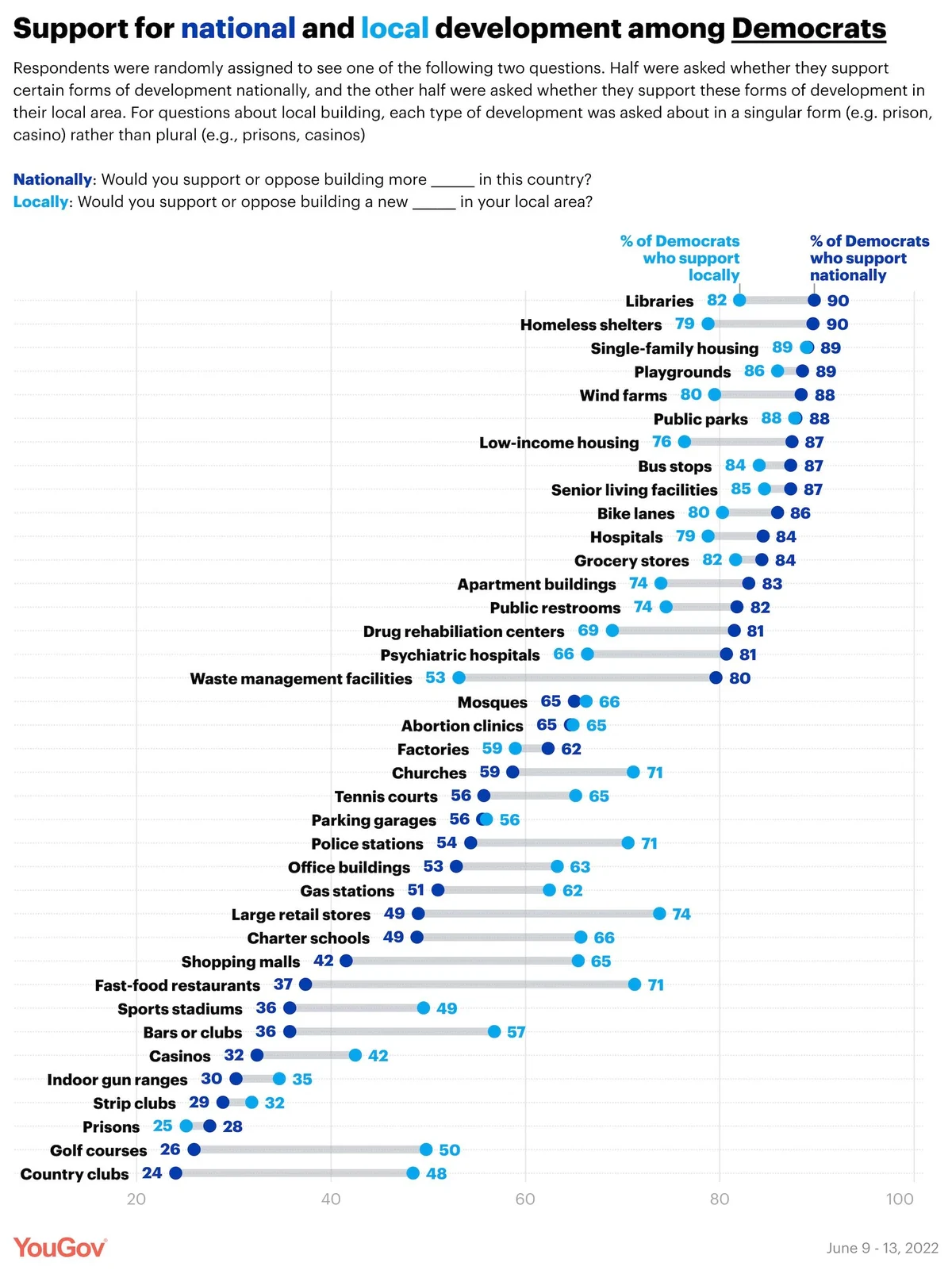
You can sort and search the data for national and local support of development by party using the table below:
Support for development among homeowners and renters
The most common way for Americans to build wealth is through homeownership. However, as some have pointed out, a fundamental tension between homeowners and aspiring homeowners underlies housing policy debates: Rising housing prices make homeownership a better investment but also make housing less affordable. As housing prices have soared in many parts of the U.S. in recent years, American homeowners have grown increasingly invested in maintaining their property values. As a result, homeowners may support development perceived as increasing property values, such as parks, while opposing development seen as decreasing property values, such as apartment buildings, which increase the supply of housing and thus could cut its cost. Thus, some theorize that homeownership, rather than partisanship, is the primary factor determining people's positions in NIMBY/YIMBY debates. (The two are connected: Homeowners are significantly more likely to be Republicans than are people who don't own their home.) Renters lack homeowners' particular financial motivation to oppose local development, though they may oppose it for other reasons, such as health and safety concerns, or the possibility of rent increases.
While we do find some differences in homeowners' and renters' support for development, the differences between these two groups are smaller than the gaps between Republicans and Democrats. In our survey, homeowners and renters are, on average, equally likely to support local development (60% average support among homeowners; 62% among renters). Homeowners are slightly more likely than renters to support national development (66% average support among homeowners; 62% among renters). At the same time, there are significant gaps in the types of development that homeowners and renters are most likely to want to see built in their communities.
For example, homeowners are more likely than renters to support the following forms of local development:
- Indoor gun ranges
- Charter schools
- Factories
- Golf courses
Renters are more likely than homeowners to support building the following locally:
- Low-income housing
- Homeless shelters
- Apartment buildings
- Psychiatric hospitals
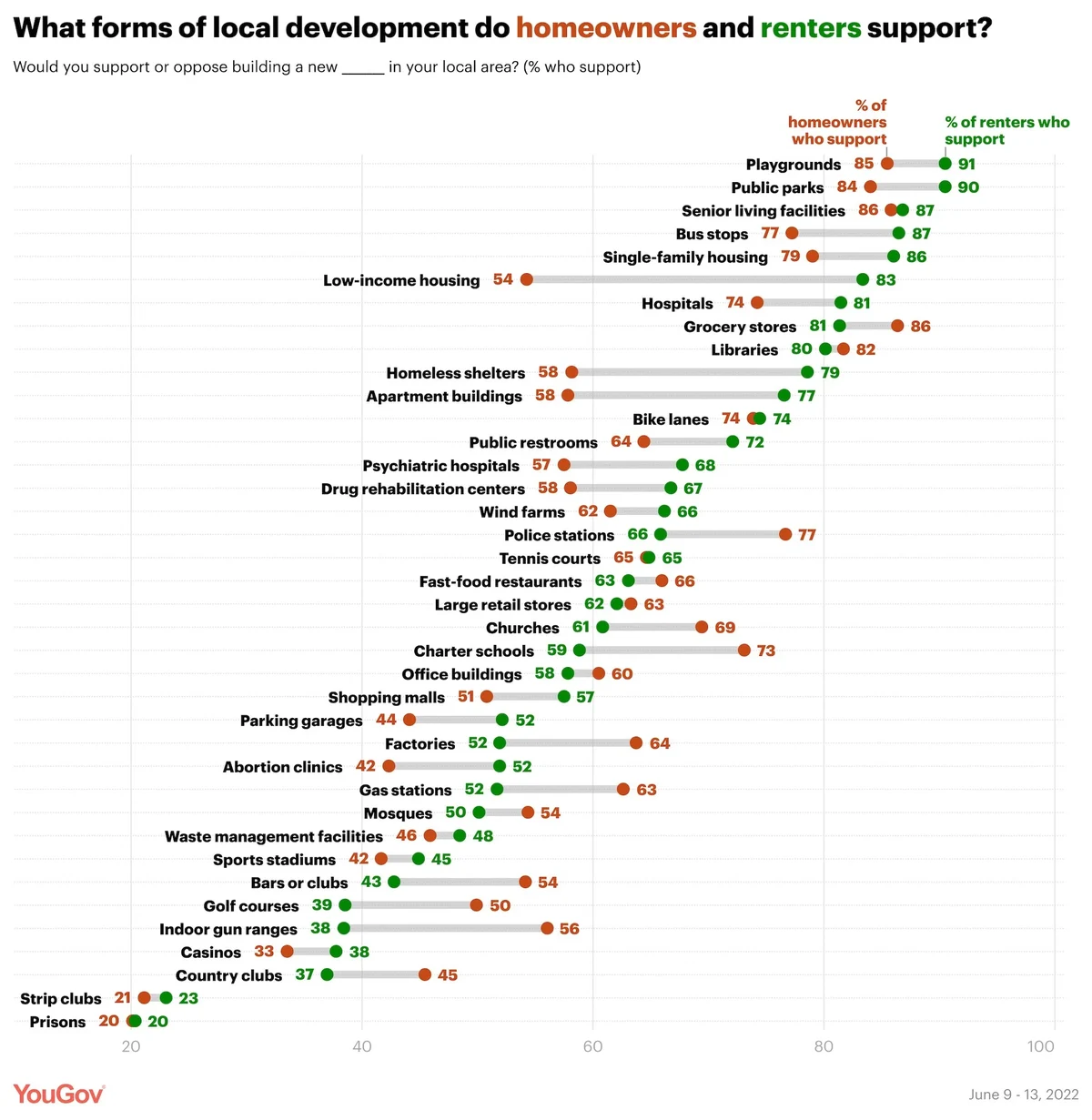
NIMBYism — or the tendency to support certain types of development, but not next door — is more prominent among homeowners than among renters in our survey. Some forms of development, such as low-income housing, are supported by renters at both a national (88%) and local level (83%), yet among homeowners, are far more likely to be supported nationally (80%) compared to locally (54%). A similar pattern is present in the two groups' support for constructing apartment buildings.
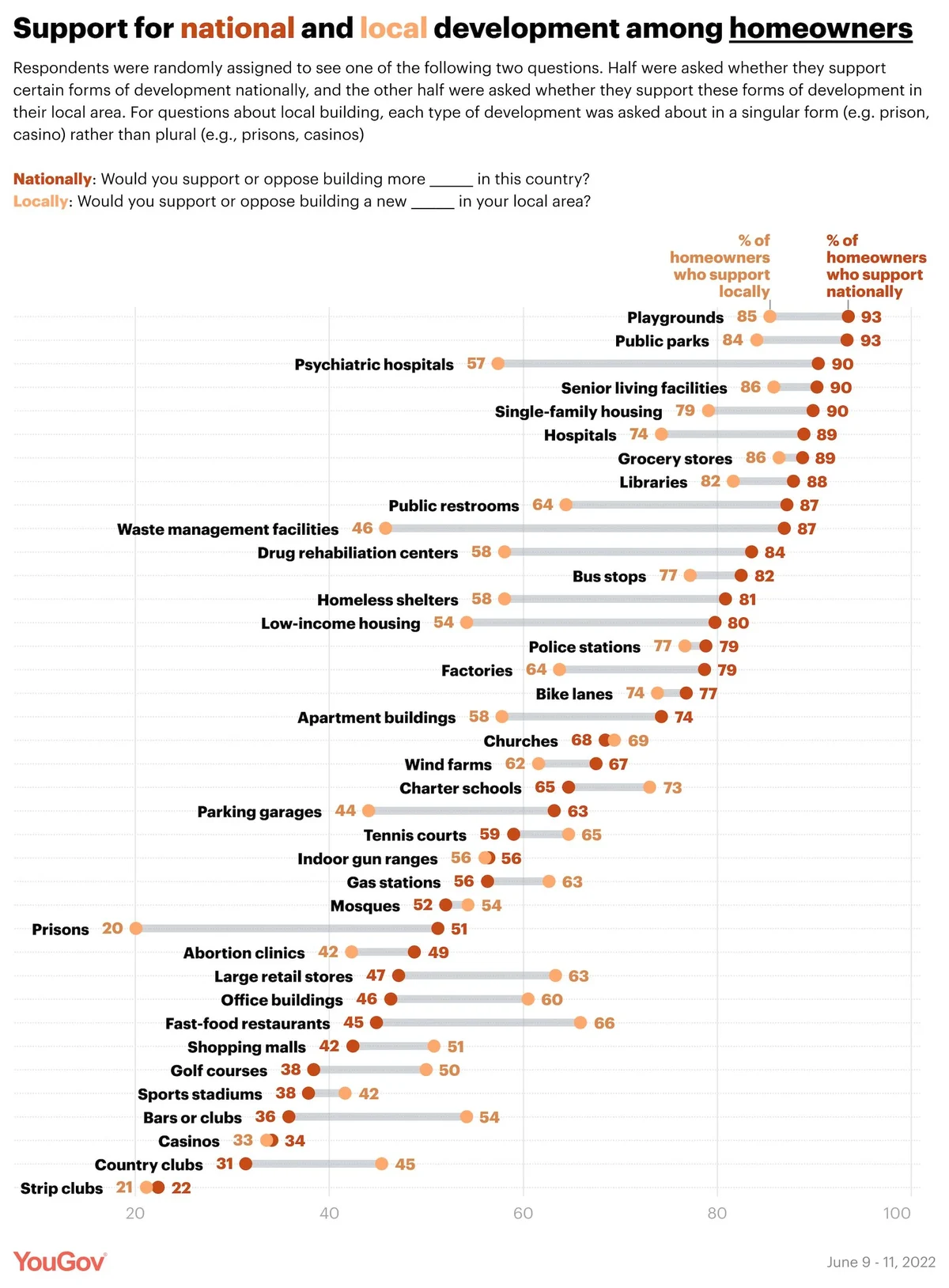
Like homeowners, renters are less likely to support the construction of waste management facilities in their local area, relative to nationally. Support is also lower locally than nationally for building prisons and drug rehabilitation facilities.
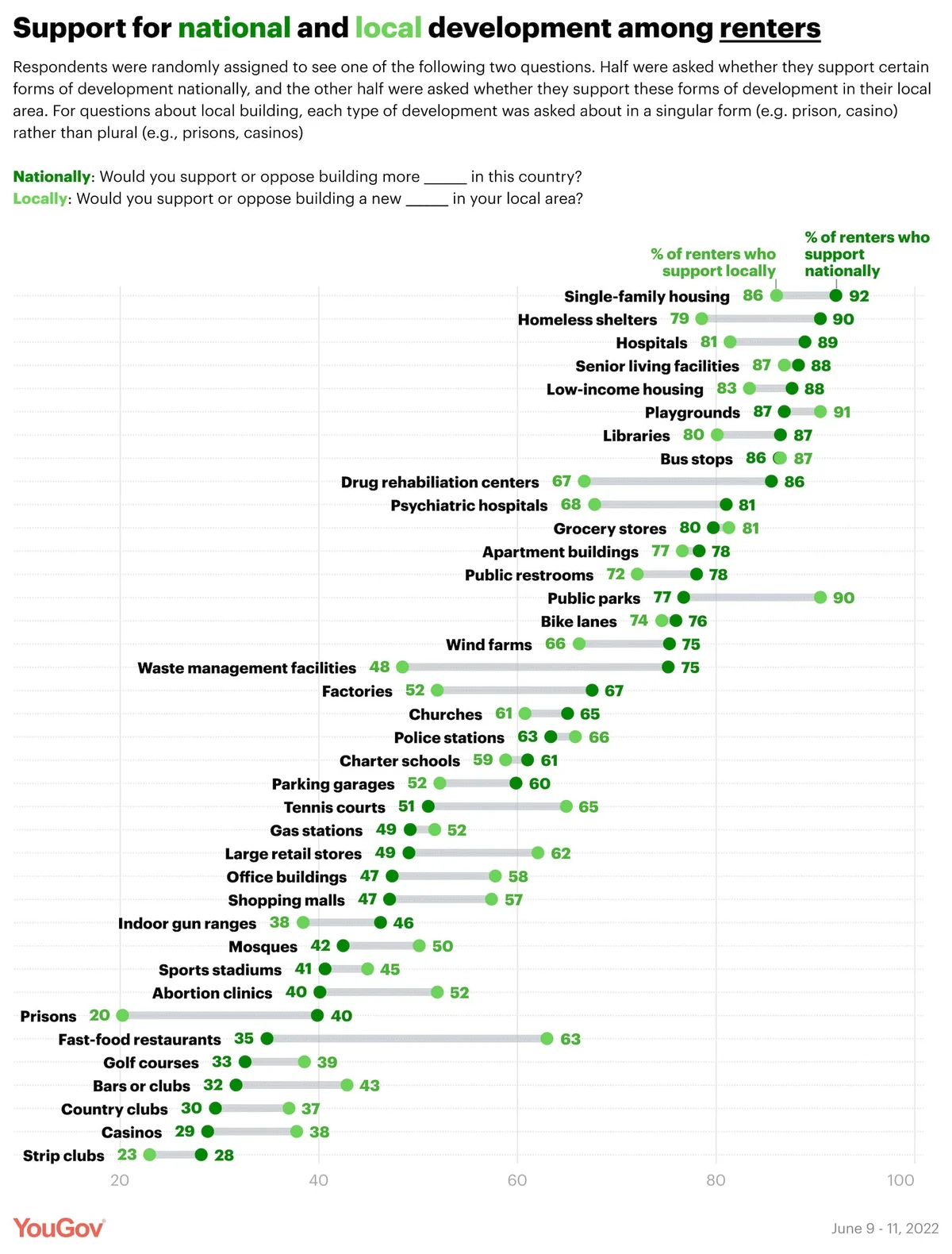
You can sort and search the data for national and local support of development among homeowners and renters using the table below:
— Linley Sanders and Mark White contributed to this article
This poll was conducted on June 9 - 13, 2022, among 1,000 U.S. adult citizens. Explore more on the methodology and data for this poll.
Image: Pexels
